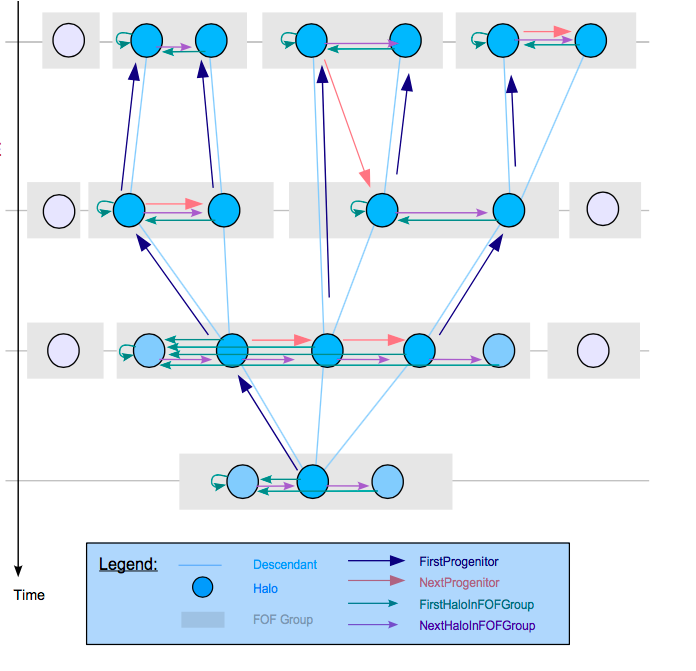A skeleton C code to read LHaloTree output. The LHaloTree is a binary file format, where the tree data for the entire simulation tree data can be split across many files. Each file contains the following fields:
Bytes per element | Datatype | Nelements | Field
-------------------------|--------------------|-------------------------|------------------------
4 bytes | unsigned int32_t | 1 | ntrees (number of trees in this file)
4 bytes | unsigned int32_t | 1 | totnhalos (total number of halos summed over all trees in this file)
4 bytes | unsigned int32_t | ntrees | nhalos_per_tree (number of halos in *each* tree in this file)
sizeof(struct lhalotree) | struct lhalotree | totnhalos | all_trees (all the halos in this file, should be parsed one tree at a time)
See these lines in lhalotree.h for the definition of struct lhalotree. A single tree will always be fully contained within one file, i.e., tree data does not split across multiple files.
There are 5 indices to navigate around LHaloTree mergertrees. A value of -1
indicates a stopping condition, i.e., no more valid halos exist. All of these
indices are tree-local, i.e., if there 1000 halos in a tree, then any of these
indices can either be -1, or in the inclusive range [0, 999].
-
Descendant-- The index of what the halo will become in the future. This can either be the halo itself, or a different halo (signifying a merger) -
FirstProgenitor-- tracks the progenitor in the past. Is equal to-1when the halo does not have any progenitors. -
NextProgenitor-- Is attached to theFirstProgenitorhalo and tracks the other progenitors. Can be in the past/present/future ofFirstProgenitor, depending on if any one of the halos skip snapshots. Is equal to-1when there are no more progenitors.NOTE
NextProgenitorof any given halo (i.e., theDescendant) is stored in theFirstProgenitorof the (Descendant) halo. The following code shows how to process all progenitors of any given halo:
/*
The `tree` variable is an array containing `nhalos`
elements of type `struct lhalotree`. This represents the entire
mergertree. Walking is accomplished by using the indices represented here
*/
int32_t halonum = 42;/* some halo that you want to process */
int32_t prog = tree[halonum].FirstProgenitor;
while(prog != -1) {
/* do something with prog here */
process_progenitor(prog, tree); /* prog is an index into the entire tree */
/* Note how you get the `NextProgenitor` index from
the `prog` index and **NOT** `halonum` */
prog = tree[prog].NextProgenitor;
}FirstHaloInFOFGroup-- The index for theFOFhalo. TheFOFhalo points to itself. Can never be-1.NextHaloInFOFGroup-- The index for the next subhalo in theFOFgroups. Is equal to-1when there are no more subhalos in thatFOFhalo.
int32_t fully_walk_tree(const int start, struct lhalotree *tree)
{
/*
Fully walks the tree -- all reachable nodes will be returned exactly once
Returns -1 when done visiting all nodes of the tree
*/
int32_t curr_halo = start;
if(tree[curr_halo].FirstProgenitor != -1) {
return tree[curr_halo].FirstProgenitor;
} else {
if(tree[curr_halo].NextProgenitor != -1) {
return tree[curr_halo].NextProgenitor;
} else {
while((tree[curr_halo].NextProgenitor == -1) && (tree[curr_halo].Descendant != -1)) {
curr_halo = tree[curr_halo].Descendant;
}
/* can return -1 (i.e., when every node has been visited) */
return tree[curr_halo].NextProgenitor;
}
}
return -1;/* un-reachable */
}In principle, each tree within a lhalotree mergertree file should contain exactly one FOF halo, and every halo contained in that tree should be reachable by those 5 mergertree indices. In such a case, the previous code is be sufficient to walk the entire tree. However, I have found that there exist multiple FOF halos at the final snapshot for a large number of trees. To ensure that you have indeed processed all halos in a given tree, you are better off with the following code
const int maxsnap = -1;
for(int32_t i=0;i<nhalos_in_this_tree;i++) {
maxsnap = tree[i].SnapNum > maxsnap ? tree[i].SnapNum:maxsnap;
}
for(int32_t i=0;i<nhalos_in_this_tree;i++) {
/* Check if the halo is a FOF halo at the final snapshot */
if(tree[i].SnapNum == maxsnap && tree[i].FirstHaloInFOFGroup == i) {
int32_t halo = i;
while(halo != -1) {
process_halo(halo);
halo = fully_walk_tree(i, tree);
}
}
}